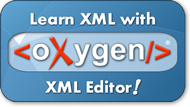XSL-FO Pages


XSL-FO uses page templates called "Page Masters" to define the layout of pages.
XSL-FO Page Templates
XSL-FO uses page templates called "Page Masters" to define the layout of
pages. Each template
must have a unique name:
<fo:simple-page-master master-name="intro">
<fo:region-body margin="5in" />
</fo:simple-page-master>
<fo:simple-page-master master-name="left">
<fo:region-body margin-left="2in" margin-right="3in" />
</fo:simple-page-master>
<fo:simple-page-master master-name="right">
<fo:region-body margin-left="3in" margin-right="2in" />
</fo:simple-page-master>
|
In the example above, three <fo:simple-page-master> elements, define three
different templates. Each template (page-master) has a different name.
The first template is called "intro". It could be used as a template for
introduction pages.
The second and third templates are called "left" and "right". They could be
used as templates for even and odd page numbers.
XSL-FO Page Size
XSL-FO uses the following attributes to define the size of a page:
- page-width defines the width of a page
- page-height defines the height of a page
XSL-FO Page Margins
XSL-FO uses the following attributes to define the margins of a page:
- margin-top defines the top margin
- margin-bottom defines the bottom margin
- margin-left defines the left margin
- margin-right defines the right margin
- margin defines all four margins
XSL-FO Page Regions
XSL-FO uses the following elements to define the regions of a page:
- region-body defines the body region
- region-before defines the top region (header)
- region-after defines the bottom region (footer)
- region-start defines the left region (left sidebar)
- region-end defines the right region (right sidebar)
Note that the region-before, region-after, region-start, and region-end is a
part of the body region. To avoid text in the body region to overwrite text in
these regions, the body region must have margins at least the size of these
regions.
| Margin Top |
M
a
r
g
i
n
L
e
f
t
|
| REGION BEFORE |
R
E
G
I
O
N
S
T
A
R
T |
REGION BODY
|
R
E
G
I
O
NE
N
D |
| REGION AFTER |
|
M
a
r
g
i
n
R
i
g
h
t |
| Margin Bottom |
|
XSL-FO Example
This is an extract from an XSL-FO document:
<fo:simple-page-master master-name="A4"
page-width="297mm" page-height="210mm"
margin-top="1cm" margin-bottom="1cm"
margin-left="1cm" margin-right="1cm">
<fo:region-body margin="3cm"/>
<fo:region-before extent="2cm"/>
<fo:region-after extent="2cm"/>
<fo:region-start extent="2cm"/>
<fo:region-end extent="2cm"/>
</fo:simple-page-master>
|
The code above defines a "Simple Page Master Template" with the name "A4".
The width of the page is 297 millimeters and the height is 210 millimeters.
The top, bottom, left, and right margins of the page are all 1 centimeter.
The body has a 3 centimeter margin (on all sides).
The before, after, start, and end regions (of the body) are all 2
centimeters.
The
width of the body in the example above can be
calculated by subtracting the left and right margins and the region-body
margins from the width of the page itself:
297mm - (2 x 1cm) - (2 x 3cm) = 297mm - 20mm - 60mm = 217mm.
Note that the regions (region-start and region-end) are not a part of the
calculation. As described earlier, these regions are parts of the body.


Learn XML with <oXygen/> XML Editor - Free Trial!
 |
|
oXygen helps you learn to define,
edit, validate and transform XML documents. Supported technologies include XML Schema,
DTD, Relax NG, XSLT, XPath, XQuery, CSS.
Understand in no time how XSLT and XQuery work by using the intuitive oXygen debugger!
Do you have any XML related questions? Get free answers from the oXygen
XML forum
and from the video
demonstrations.
Download a FREE 30-day trial today!
|
|